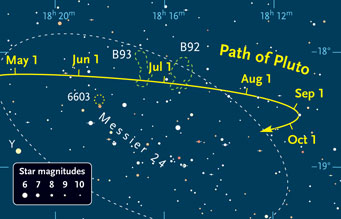Have you ever seen Pluto through a telescope? Do you want to try? All you need is a good 8-inch scope, access to dark skies, lots of persistence, and excellent star charts.
We can't help you with the telescope, dark-sky site, or necessary character qualities. But this article contains all the charts you need to locate Pluto in May or June 2010. The July issue of Sky & Telescope includes charts for July through October.

Click on the chart above for a full-page PDF chart showing how to locate Pluto in May and June 2010.
Tony Flanders
This is one of the best years in Pluto's 249-year orbit around the Sun to view the dwarf planet. In May and June, it crosses Messier 24, the Small Sagittarius Star Cloud, one of the pieces of sky most densely packed with stars. A high-power telescopic field of view will include hundreds of stars comparable to Pluto in brightness. Then, in July, Pluto crosses Barnard 92, one of the most prominent of all dark clouds, where typical backyard telescopes show no stars whatsoever.
Whether you call it a planet, a dwarf planet, a minor planet, an asteroid, a comet — or all of the above — Pluto is a special object. It's the most distant chunk of solid material that can be seen through the eyepiece of normal backyard telescopes.
Pluto is almost impossible to see when the Moon is up, so each month there's a two or three-week window of visibility, depending precisely where you live. At mid-northern latitudes, these windows are roughly:
May 6-24 from 2 a.m. to dawn
June 3-22 from midnight to 3 a.m.
July 2-19 from nightfall to 1 a.m.
Aug. 1-15 from nightfall to 11:30 p.m.
Aug. 29 - Sept. 11 from nightfall to 9:30 p.m.
Sept. 27 - Oct. 9 at nightfall
 0
0
Comments
You must be logged in to post a comment.